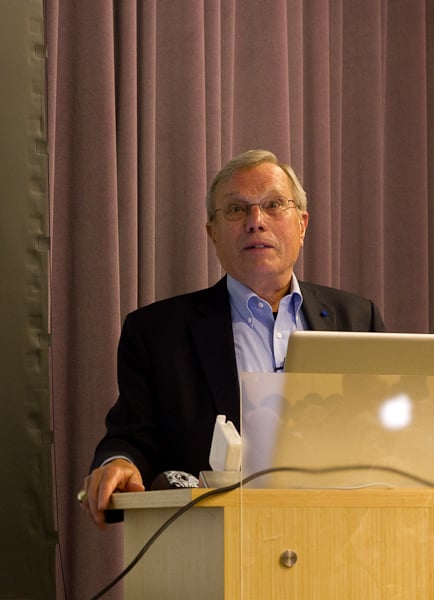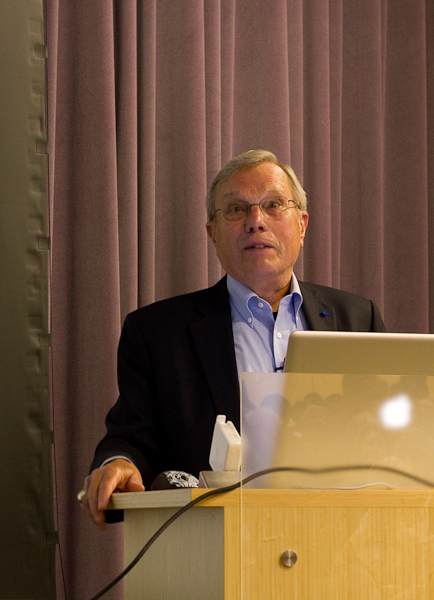
The 1973 creation of Global Positioning System (GPS) technology, which uses satellites to determine precise locations on Earth, changed industries ranging from aviation to robotics. Professor emeritus Bradford Parkinson, the engineer and inventor known as the architect of GPS, delivered a “Stanford Engineering Hero” lecture Monday about his work.
“GPS has many applications for worldwide benefit,” Parkinson said. “Some we anticipated, some are surprising.”
As a colonel in the U.S. Air Force, Parkinson made strides in his aeronautics and astronautics engineering studies as a doctoral student at Stanford. In 1973, he became manager of the NAVSTAR GPS development program, where he remained until 1978, when he retired from the Air Force. He then served as a professor at Stanford until 1999.
Parkinson described the origins and applications of GPS Monday and explored the trajectory of its future. He dedicated his lecture to the aerospace engineers who work to advance technology in the field today.
The origins of GPS date back to 1964, when Ivan Getting, who later worked with Parkinson, envisioned a worldwide navigation system and sponsored a study. The first GPS systems study was from 1964 to 1966.
Throughout Parkinson’s involvement in GPS engineering, the technology has undergone several phases of development and advanced to incorporate new generations of technology.
“Back in ‘74, we knew we could do aircraft GPS,” Parkinson said. “The surprise was in 1992, when we discovered that the implication of what we are doing is far better than a meter — it is on the level of a few inches in three dimensions.”
Parkinson identified two defining events in the history of GPS.
“The first was in 1983, when the Soviets shot down an airliner on September 1. Within two weeks Reagan declared to the world that GPS would be available within two weeks,” Parkinson said. “The second was in 2001, when Clinton ordered deliberate errors in the system turned off.”
After recounting the history of GPS, Parkinson identified 10 major fields that have advanced because of the technology. He described the GPS applications involved in aviation, emergency services, timing, agriculture, rescue, recreation, automotive tracking, science, military, robotics and machine control.
Everyday automobile drivers experience the usefulness of GPS in locating their destinations. The applications of GPS in navigation are manifold, and continually expanding.
“In 1974 we could do land navigation. In 1976, automatic steering to an inch,” Parkinson said.
In addition, the origin of coordinated international time can be attributed to GPS.
“A man with one watch knows what time it is, a man with two watches is not sure,” Parkinson said. Countries throughout the globe now operate on synchronized time.
“The idea is that users on either side of the Atlantic look at the same satellite to identify the time,” Parkinson continued.
GPS technology is also widely applied in communication.
“Almost all cell phone towers trace their origin back to GPS,” Parkinson said.
Parkinson also touched on the effects of the power of GPS for humanity. Narrating an example of a military rescue from 1995, he outlined the role of GPS in changing the face of rescue capability. The incident involved a soldier who was shot down and found six days later by military rescue teams.
“[The soldier] attributed his success to faith in God, courage of the rescuers, and GPS, which he referred to as his guiding light,” Parkinson said.
Despite the widespread applications of GPS, there exist some tangible challenges in the technology’s future.
“The number one foreseeable problem I believe is spectrum interference,” Parkinson said. He explained how devices may interfere with a satellite or other signal.
Despite where GPS technology might go in the future, Parkinson expressed amazement at the applications that have already been found.
“Though we usually think of space in three dimensions, GPS is really four dimensional,” Parkinson said. “GPS is more than simply a satellite system, it’s the services it renders.”
